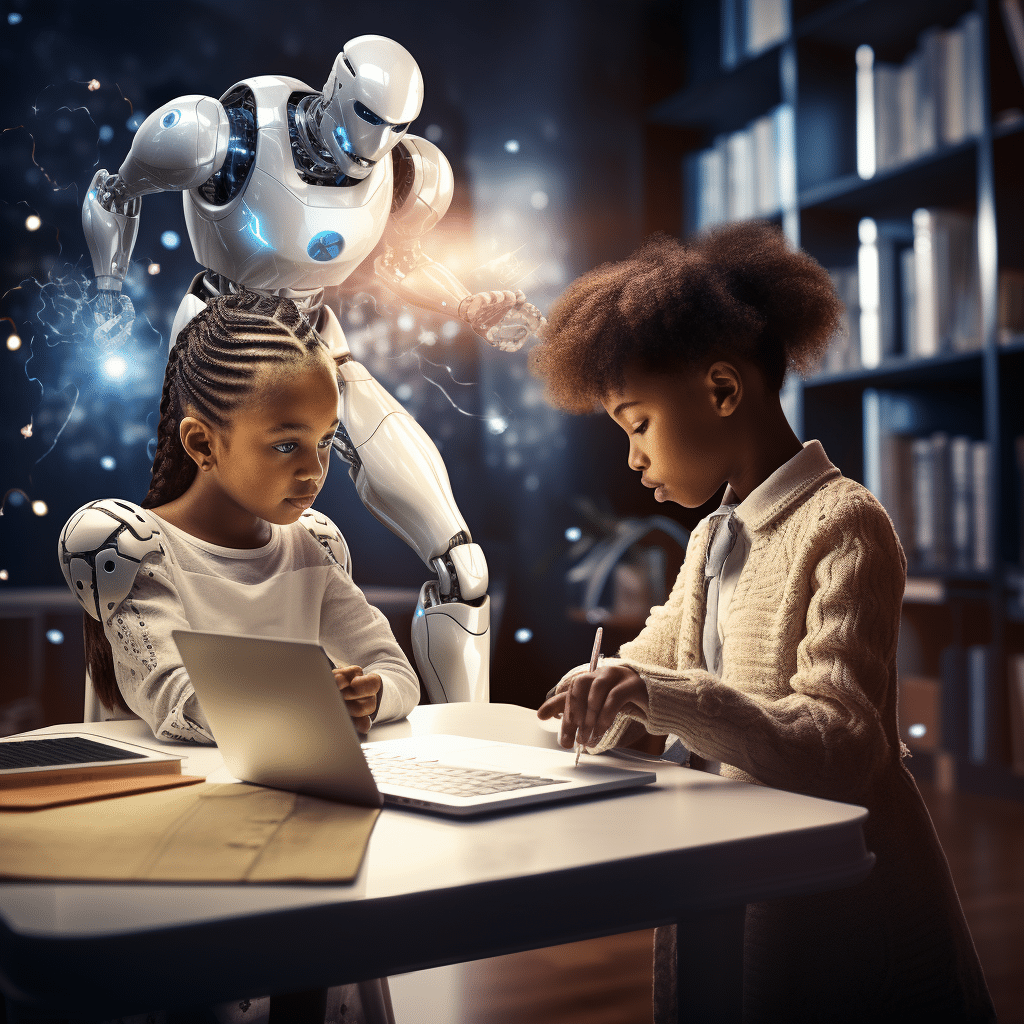
AI in Education Equity: Addressing the Digital Divide

The digital divide refers to the inequality in access to digital technologies among different socioeconomic groups, leading to disparities in education outcomes. This problem has become even more prominent in today’s technology-driven world. However, artificial intelligence (AI) is emerging as a powerful tool to bridge this gap and promote education equity for all.
AI can play a crucial role in addressing the digital divide by:
Providing personalized learning experiences
AI-powered educational platforms can adapt to the unique needs and pace of individual students, ensuring that no one is left behind due to limited resources or inadequate instruction.
Enhancing access to quality educational resources
With the help of AI algorithms, educational content can be curated and customized to suit various learning styles and abilities, facilitating equal access to high-quality materials for all students.
Supporting remote and distance learning
AI technologies enable remote learning by providing virtual classrooms, interactive video lectures, and real-time communication tools that ensure students can participate in education regardless of their geographical location or physical limitations.
Identifying learning gaps and providing targeted interventions
AI algorithms can analyze large volumes of data to identify learning gaps in individual students or entire groups. With this insight, educators can tailor interventions and resources to address specific areas of weakness, ultimately reducing educational disparities.
By harnessing the potential of AI in education, we can hope to bridge the digital divide and ensure equal opportunities for all students. However, it is essential to address the challenges associated with AI implementation, such as data privacy, algorithmic biases, and the need for proper infrastructure. Through collaborative efforts between policymakers, educators, and technology experts, we can build a future where AI acts as an enabler of education equity.
To learn more about AI’s impact on education equity, check out the following resources:
How can policymakers and educational institutions collaborate to maximize the benefits of AI in education equity while minimizing potential biases or inequalities
There are several ways policymakers and educational institutions can collaborate to ensure the benefits of AI in education are maximized while minimizing potential biases or inequalities:
1. Establish guidelines and regulations
Policymakers can work closely with educational institutions to develop guidelines and regulations that promote fairness, transparency, and equity in AI systems. These guidelines can ensure that AI algorithms used in education do not perpetuate biases or discriminate against certain groups of students.
2. Foster transparency and accountability
Policymakers can encourage educational institutions to be transparent about the AI systems they use by making information about their algorithms, data sources, and decision-making processes available to the public. This transparency will allow stakeholders to identify and address potential biases or inequalities.
3. Conduct regular audits and assessments
Educational institutions can collaborate with policymakers to conduct regular audits and assessments of their AI systems. These audits can help identify any biases or inequalities in how AI algorithms are being used and allow for necessary corrective actions to be taken.
4. Promote diversity and inclusivity
Educational institutions can work with policymakers to ensure that the teams developing and implementing AI systems in education are diverse and inclusive. This can help mitigate potential biases and ensure that a wide range of perspectives are considered in the design and deployment of AI technologies.
5. Incorporate ethical education and awareness
Policymakers and educational institutions can collaborate to integrate programs and courses that teach students about the ethical implications of AI and how it can impact equity in education. By equipping students with the knowledge and skills to understand and critically evaluate AI systems, they can become active participants in promoting fairness and minimizing potential biases.
6. Engage in ongoing research and development
Policymakers and educational institutions can collaborate on research and development efforts to continually improve AI systems in education. Through continuous monitoring and improvement, policymakers and educational institutions can identify and rectify biases or inequalities as they arise.
Overall, effective collaboration between policymakers and educational institutions is crucial to maximize the benefits of AI in education equity while minimizing potential biases or inequalities. By working together, they can create an ecosystem that promotes fairness, transparency, and inclusivity in AI systems used in education.
What are the potential limitations or challenges associated with using AI in education to address the digital divide, and how can they be overcome?
There are several potential limitations and challenges associated with using AI in education to address the digital divide:
1. Access to technology
AI solutions often require access to reliable internet connectivity and necessary hardware (such as computers or smartphones). However, in underserved areas with the digital divide, access to such technology may be limited. Overcoming this challenge requires the provision of affordable and accessible technology infrastructure to bridge the digital divide.
2. Technological literacy
AI systems may be complex and require a certain level of technological literacy to operate effectively. Teachers, students, and administrators may need training to understand and utilize AI tools. Providing training and professional development opportunities can help overcome this challenge.
3. Language and cultural barriers
AI systems may face challenges in adapting to different languages, dialects, or cultural contexts. AI models need to be trained and fine-tuned to accommodate diverse linguistic and cultural variations to ensure equitable access. This can be achieved through extensive data collection and collaboration with linguists and experts from various backgrounds.
4. Bias and fairness
AI systems can unintentionally perpetuate biases present in the data used to train them. This can lead to unfair outcomes and exacerbate existing inequalities. Designing AI algorithms that are transparent, accountable, and continuously monitored for biases can help address this challenge.
5. Individualized learning
AI has the ability to make learning more personalized and flexible. But making different learning paths for each student can be hard and take a lot of resources, especially in large-scale education systems. To solve this problem, it’s important to build AI models and systems that can be scaled up.
To get around these problems and limitations, you need a multifaceted method. It means investing in technology infrastructure and making sure everyone has access to it, giving teachers and students training and support, taking linguistic and cultural diversity into account, fixing bias in AI algorithms, and making AI systems that can be scaled up to meet the needs of all learners. Researchers, policymakers, teachers, and people who make technology must work together to make sure that AI in education is accessible, fair, and effective at closing the digital gap.
What are some examples of AI-powered tools or platforms that have successfully promoted education equity by addressing the digital divide?

AI-powered tools and platforms have played a crucial role in promoting education equity by addressing the digital divide. Here are some examples:
1. Adaptive Learning Platforms: Tools like Knewton and DreamBox Learning use AI algorithms to provide personalized learning experiences to students, taking into account their individual needs and learning pace. This helps bridge the gap between students with varying access to resources and ensures an equitable learning experience.
2. Virtual Learning Environments: Platforms such as Moodle and Blackboard leverage AI to support remote learning and provide equal access to resources for students regardless of their geographical location. These platforms offer features like online courses, discussion forums, and virtual classrooms, helping diminish the digital divide.
3. Language Learning Apps: AI-powered language learning apps like Duolingo and Babbel offer personalized learning paths that adapt to individual learners. This benefits students who may not have access to language courses or tutors, providing them with an equitable opportunity to learn a new language and broaden their horizons.
4. Digital Libraries: AI-driven digital libraries such as The Global Digital Library and OpenAI’s GPT-3 text generation are working towards making educational resources accessible to underserved communities. These libraries provide free access to a wide range of educational materials, improving access to knowledge across different socioeconomic backgrounds.
5.Tutoring & Digital Assistants: Khan Academy and IBM Watson give students with tailored and interactive guidance. These solutions provide superior educational support to pupils regardless of location or instructor availability.
These technologies and platforms have addressed the digital divide and given all students equal learning chances by using AI.








